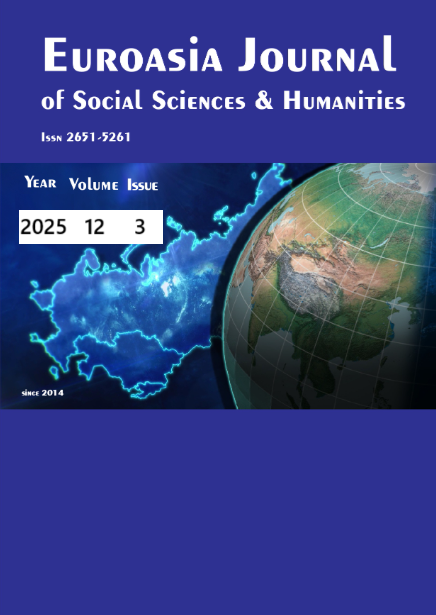A STUDY ON SUPPORTING THE GEOMETRIC THINKING PERCEPTIONS OF PRIMARY SCHOOL 4TH GRADE STUDENTS WHO MISDIAGNOSIS THE SHAPE WHEN THE DIRECTION OF THE GEOMETRIC SHAPE CHANGES WITH AUGMENTED REALITY AND EDUCATIONAL SOFTWARE
DOI:
https://doi.org/10.5281/zenodo.15767563Keywords:
Geometry, Geometric perception, Geometric Thinking Skills, Geometric Thinking Skills Scale, Educational Software, Augmented RealityAbstract
Studies in the literature show that students in preschool, primary school first and second grades, and even teachers think that when the direction of a geometric shape changes, the shape also changes. This article is about developing geometric thinking skills of students who do not perceive what the shape is when the direction of the shape changes, with the support of educational software and augmented reality. With the “Geometric thinking skill level determination scale” applied to 100 primary school students, it was determined that 31 students could not recognize the square when the direction of the square changed. It is also very difficult for students who cannot recognize the geometric shape in a 2-dimensional environment to perceive geometric objects in 2-dimensional environments in advanced subjects. In order to solve this problem, after the applications with augmented reality and educational software with 16 students out of a total of 32 students, randomly selected as experimental and control groups, when the direction of the square was changed in the "Geometric thinking skill level determination scale", no significant increase was observed in the control group in the rate of correct answers given to the question of perceiving and defining the shape, while a significant increase was observed in the experimental group from the pre-test to the re-test, indicating that the application with the experimental group was effective.
Downloads
References
Akkaya, S. (2018). İlkokul dördüncü sınıf matematik dersinde geometri alt öğrenme alanlarına ilişkin kavram yanılgılarının giderilmesinde oyun temelli öğretimin etkisi (Tez No.520308) [Doktora tezi, İnönü Üniversitesi]. YÖK Ulusal Tez Merkezi
Aktaş D. Y. ve Aktaş M. C. (2012). 8.sınıf öğrencilerinin özel dörtgenleri tanıma ve aralarındaki hiyerarşik sınıflamayı anlama durumları. İlköğretim Online, 11(3), 714-728: http://ilkogretimonline.org.tr.
Bayram, G. ve Duatepe Paksu, A. (2018). Sekizinci sınıf öğrencilerinin paralelkenara ilişkin oluşturdukları örnekler bağlamında kavram imajları ve yaptıkları tanımlar. 27th International Conference on Educational Sciences, Antalya, Türkiye. https://www.researchgate.net/publication/328383432_Sekizinci_Sinif_Ogrencilerinin_Paralelkenara_Iliski n_Olusturduklari_Ornekler_Baglaminda_Kavram_Imajlari_Ve_Yaptiklari_Tanimlar
Çokluk, Ö., Şekercioğlu, G. ve Büyüköztürk, Ş. (2023). Sosyal Bilimler İçin Çok Değişkenli İstatistik: SPSS ve Lisrel Uygulamaları, (7. bs.). Ankara: Pegem Akademi Yayıncılık.
Çontay E. G., Duatepe Paksu A. (2022). Erciyes Journal of Education 2022, Vol 6, No 2, 166-190 189 https://dergipark.org.tr/tr/download/article-file/2174587
Ergün, S. (2010). İlköğretim 7. Sınıf öğrencilerinin çokgenleri algılama, tanımlama ve sınıflama biçimleri. Yüksek Lisans Tezi, Dokuz Eylül Üniversitesi. https://acikerisim.deu.edu.tr/xmlui/bitstream/handle/20.500.12397/7082/265518.pdf?sequence=1&isAll owed=
Ferketich, S. (1991). Focus on psychometrics: Aspects of item analysis. Research in Nursing & Health, 14(2), 165–168. https://doi.org/10.1002/nur.4770140211
Field, A. (2018). Discovering statistics using IBM SPSS statistics: North American edition. SAGE.
Gökkurt, B., Koçak, M. ve Soylu, Y. (2014). Öğretmen adaylarının kesirler konusuna yönelik konu alan bilgileri ve öğretim stratejileri bilgilerinin incelenmesi. 11. Ulusal Fen Bilimleri ve Matematik Eğitimi Kongresinde sunulan sözlü bildiri. Adana: Çukurova Üniversitesi.
Gökkurt, B., ve Soylu, Y. (2016). Ortaokul matematik öğretmenlerinin pedagojik alan bilgilerinin incelenmesi: koni örneği. İlköğretim Online, 15(3), 946- 973.
Gürbüz, S. (2024). AMOS ile Yapısal Eşitlik Modellemesi (3. Baskı). Ankara: Seçkin Yayıncılık.
Hair, J. F., Black, W. C., Babin, B. J., & Anderson, R. E. (2010). Multivariate data analysis (7th ed.). Pearson Prentice Hall.
Herbst, P., Gonzalez, G., & Macke, M. (2005). How can Geometry Students Understand What it Means to Define in Mathematics? The Mathematics Educator, 15(2), 17-24.
Howard, M. C. (2016). A Review of Exploratory Factor Analysis Decisions and Overview of Current Practices: What We Are Doing and How Can We Improve? International Journal of Human–Computer Interaction, 32(1), 51–62. https://doi.org/10.1080/10447318.2015.1087664
İncikabı L., Ç Kılıç. (2013). An Analysis of Primary School Students’ Conceptual Knowledge of Geometric Solids. Kuramsal Eğitimbilim Dergisi, 6(3), 343-358, Temmuz 2013 Journal of Theoretical Educational Science, 6(3), 343-358, July 2013 [Online]: http://www.keg.aku.edu.tr DOI number: http://dx.doi.org/10.5578/keg.5920
Kaiser, H. F., & Rice, J. (1974). Little Jiffy, Mark IV. Educational and Psychological Measurement, 34(1), 111–117. https://doi.org/10.1177/001316447403400115
Kesicioğlu O., S., Alisinanoğlu F. Tuncer A., T. (2011). The Analysis of Kindergarteners` Recognition Degrees of Geometric Shapes Elementary Education Online, 10(3), 1093-1111, 2011. İlköğretim Online, 10(3), 1093-1111, 2011. [Online]: http://ilkogretim-online.org.tr
Monaghan, F. (2000). What Difference Does It Make? Children’s Views Of The Differences Between Some Quadrilaterals. Educational Studies in Mathematics, 42(2),179-196.
Okazaki, M., & Fujita, T. (2007). Prototype phenomena and common cognıtıve paths in the understanding of the inclusion relations between quadrilaterals in Japan and Scotland. Proceedings of the 31st Conference of the Internatıonal Group for the Psychology of Mathematics Education, 4, 41-48.
Stevens, J. (2002). Applied multivariate statistics for the social sciences (4th ed.). Lawrence Erlbaum Associates.
Downloads
Published
How to Cite
Issue
Section
License
Copyright (c) 2025 EUROASIA JOURNAL OF SOCIAL SCIENCES & HUMANITIES

This work is licensed under a Creative Commons Attribution-NonCommercial 4.0 International License.

